(完整版)介词短语置于句置时的倒装
- 格式:doc
- 大小:31.01 KB
- 文档页数:2
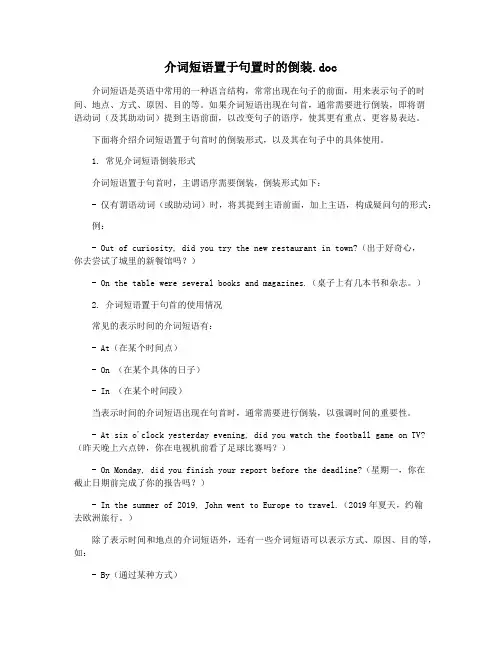
介词短语置于句置时的倒装.doc介词短语是英语中常用的一种语言结构,常常出现在句子的前面,用来表示句子的时间、地点、方式、原因、目的等。
如果介词短语出现在句首,通常需要进行倒装,即将谓语动词(及其助动词)提到主语前面,以改变句子的语序,使其更有重点、更容易表达。
下面将介绍介词短语置于句首时的倒装形式,以及其在句子中的具体使用。
1. 常见介词短语倒装形式介词短语置于句首时,主谓语序需要倒装,倒装形式如下:- 仅有谓语动词(或助动词)时,将其提到主语前面,加上主语,构成疑问句的形式:例:- Out of curiosity, did you try the new restaurant in town?(出于好奇心,你去尝试了城里的新餐馆吗?)- On the table were several books and magazines.(桌子上有几本书和杂志。
)2. 介词短语置于句首的使用情况常见的表示时间的介词短语有:- At(在某个时间点)- On (在某个具体的日子)- In (在某个时间段)当表示时间的介词短语出现在句首时,通常需要进行倒装,以强调时间的重要性。
- At six o'clock yesterday evening, did you watch the football game on TV?(昨天晚上六点钟,你在电视机前看了足球比赛吗?)- On Monday, did you finish your report before the deadline?(星期一,你在截止日期前完成了你的报告吗?)- In the summer of 2019, John went to Europe to travel.(2019年夏天,约翰去欧洲旅行。
)除了表示时间和地点的介词短语外,还有一些介词短语可以表示方式、原因、目的等,如:- By(通过某种方式)- For(为了)- With(带着,用)3. 注意事项在使用介词短语时,需要注意以下几点:- 介词短语置于句首时,需要进行倒装;- 倒装后的句子语序不同于肯定句和否定句,需要注意;- 介词短语需要与主语和谓语动词(及其助动词)搭配使用;- 介词短语的使用需要根据句子意思和语境进行更加精准的运用。
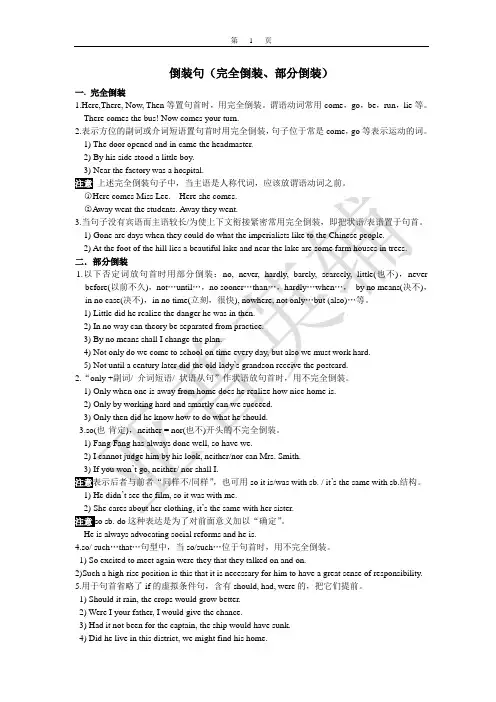
倒装句(完全倒装、部分倒装)一. 完全倒装1.Here,There, Now, Then等置句首时,用完全倒装。
谓语动词常用come,go,be,run,lie等。
There comes the bus! Now comes your turn.2.表示方位的副词或介词短语置句首时用完全倒装,句子位于常是come,go等表示运动的词。
1) The door opened and in came the headmaster.2) By his side stood a little boy.3) Near the factory was a hospital.上述完全倒装句子中,当主语是人称代词,应该放谓语动词之前。
○1Here comes Miss Lee. Here she comes.○2Away went the students. Away they went.3.当句子没有宾语而主语较长/为使上下文衔接紧密常用完全倒装,即把状语/表语置于句首。
1) Gone are days when they could do what the imperialists like to the Chinese people.2) At the foot of the hill lies a beautiful lake and near the lake are some farm houses in trees. 二.部分倒装1.以下否定词放句首时用部分倒装:no, never, hardly, barely, scarcely, little(也不),neverbefore(以前不久),not…until…,no sooner…than…,hardly…when…,by no means(决不),in no case(决不),in no time(立刻,很快), nowhere, not only…but (also)…等。
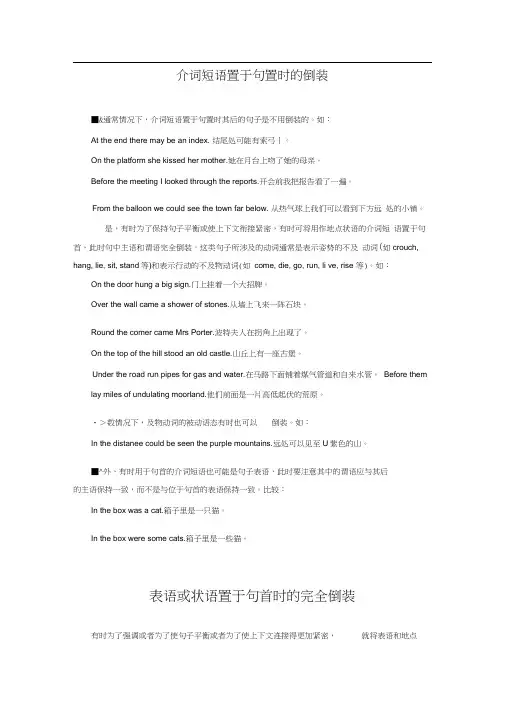
介词短语置于句置时的倒装■&通常情况下,介词短语置于句置时其后的句子是不用倒装的。
如:At the end there may be an index. 结尾处可能有索弓丨。
On the platform she kissed her mother.她在月台上吻了她的母亲。
Before the meeting I looked through the reports.开会前我把报告看了一遍。
From the balloon we could see the town far below. 从热气球上我们可以看到下方远处的小镇。
是,有时为了保持句子平衡或使上下文衔接紧密,有时可将用作地点状语的介词短语置于句首,此时句中主语和谓语完全倒装。
这类句子所涉及的动词通常是表示姿势的不及动词(如crouch, hang, lie, sit, stand等)和表示行动的不及物动词(如come, die, go, run, li ve, rise 等)。
如:On the door hung a big sign.门上挂着一个大招牌。
Over the wall came a shower of stones.从墙上飞来一阵石块。
Round the comer came Mrs Porter.波特夫人在拐角上出现了。
On the top of the hill stood an old castle.山丘上有一座古堡。
Under the road run pipes for gas and water.在马路下面铺着煤气管道和自来水管。
Before them lay miles of undulating moorland.他们前面是一片高低起伏的荒原。
・>数情况下,及物动词的被动语态有时也可以倒装。
如:In the distanee could be seen the purple mountains.远处可以见至U紫色的山。
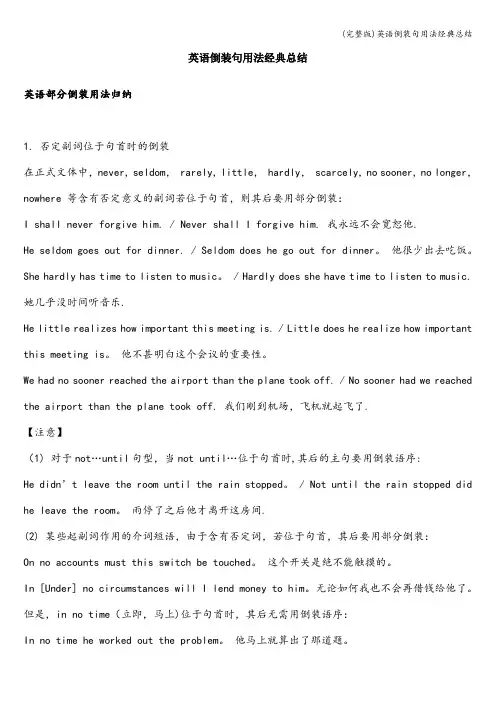
英语倒装句用法经典总结英语部分倒装用法归纳1. 否定副词位于句首时的倒装在正式文体中,never, seldom, rarely, little, hardly, scarcely, no sooner, no longer,nowhere 等含有否定意义的副词若位于句首,则其后要用部分倒装:I shall never forgive him. / Never shall I forgive him. 我永远不会宽恕他.He seldom goes out for dinner. / Seldom does he go out for dinner。
他很少出去吃饭。
She hardly has time to listen to music。
/ Hardly does she have time to listen to music. 她几乎没时间听音乐.He little realizes how important this meeting is. / Little does he realize how important this meeting is。
他不甚明白这个会议的重要性。
We had no sooner reached the airport than the plane took off. / No sooner had we reached the airport than the plane took off. 我们刚到机场,飞机就起飞了.【注意】(1) 对于not…until句型,当not until…位于句首时,其后的主句要用倒装语序:He didn’t leave the room until the rain stopped。
/ Not until the rain stopped did he leave the room。
雨停了之后他才离开这房间.(2) 某些起副词作用的介词短语,由于含有否定词,若位于句首,其后要用部分倒装:On no accounts must this switch be touched。
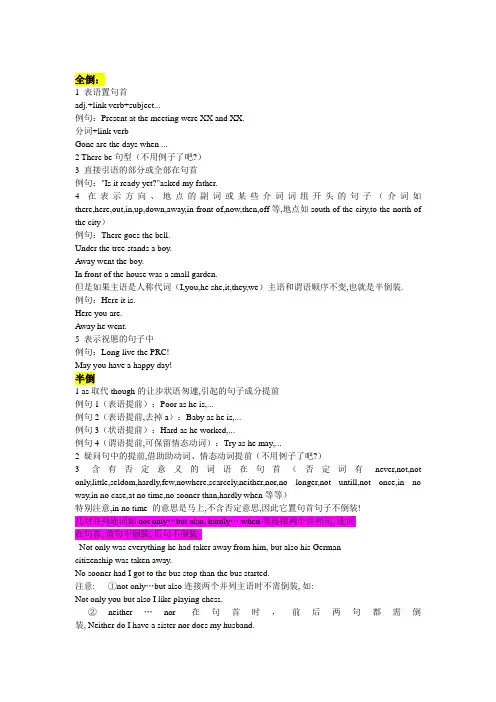
全倒:1 表语置句首adj.+link verb+subject...例句:Present at the meeting were XX and XX.分词+link verbGone are the days when ...2 There be句型(不用例子了吧?)3 直接引语的部分或全部在句首例句:"Is it ready yet?"asked my father.4 在表示方向、地点的副词或某些介词词组开头的句子(介词如there,here,out,in,up,down,away,in front of,now,then,off等,地点如south of the city,to the north of the city)例句:There goes the bell.Under the tree stands a boy.Away went the boy.In front of the house was a small garden.但是如果主语是人称代词(I,you,he she,it,they,we)主语和谓语顺序不变,也就是半倒装.例句:Here it is.Here you are.Away he went.5 表示祝愿的句子中例句:Long live the PRC!May you have a happy day!半倒1 as取代though的让步状语匆遽,引起的句子成分提前例句1(表语提前):Poor as he is,...例句2(表语提前,去掉a):Baby as he is,...例句3(状语提前):Hard as he worked,...例句4(谓语提前,可保留情态动词):Try as he may,...2 疑问句中的提前,借助助动词、情态动词提前(不用例子了吧?)3 含有否定意义的词语在句首(否定词有never,not,not only,little,seldom,hardly,few,nowhere,scarcely,neither,nor,no longer,not untill,not once,in no way,in no case,at no time,no sooner than,hardly when等等)特别注意,in no time 的意思是马上,不含否定意思,因此它置句首句子不倒装!几对并列连词如not only…but also, hardly… when等连接两个并列句, 连词在句首, 前句半倒装, 后句不倒装:Not only was everything he had taker away from him, but also his Germancitizenship was taken away.No sooner had I got to the bus stop than the bus started.注意: ①not only…but also连接两个并列主语时不需倒装, 如:Not only you but also I like playing chess.②neither…nor在句首时,前后两句都需倒装, Neither do I have a sister nor does my husband.例句:Not only was there no electricity,but also no water.Never will he forget his first time to take a plane.Hardly had I got out of the house when it began to rain.4 Only修饰的副词、介词短语或状语从句置句首时例句:Only then did I begin my work.Only if you ask many different questions will you acquire all the information.Only in this way can you learn from your friends.5 so,neither,nor引起的句子,表示前面的情况也适合另一人或同一人的另一情况时.例句:My sister enjoys traveling. So do I.I don't know and nor do I care.前后的谓语要保持时态一致.如果前面主句中既有谓语动词又有系动词,或者一半肯定一半否定,则用句子So it is/was with sb.6 在so/such...that...结构中,so/such放句首时主句倒装, that从句不倒装:例句:So proud was he that he never listened to any advice.Such a kind person is he that...7 虚拟条件从句省略if时(只有if后面跟should,had,were时可省略if)例句:Should you need more information,please let me know.Had Mark invited me I would have been glad to come.8、当Not until引出主从复合句,主句倒装,从句不倒装。
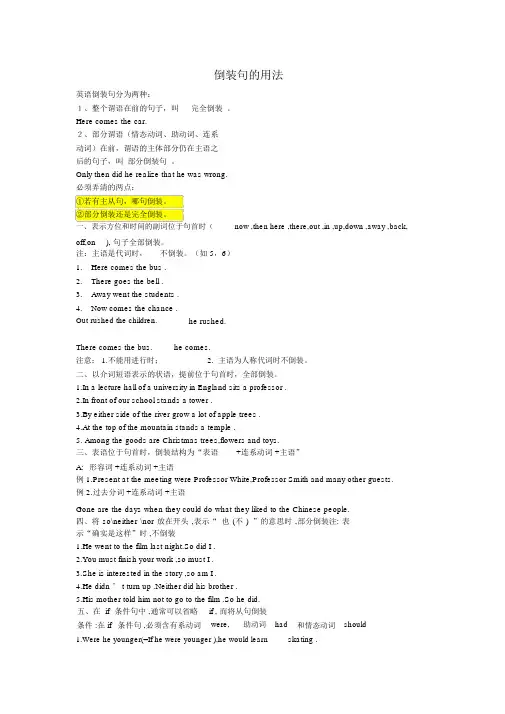
倒装句的用法英语倒装句分为两种:1、整个谓语在前的句子,叫完全倒装。
Here comes the car.2、部分谓语(情态动词、助动词、连系动词)在前,谓语的主体部分仍在主语之后的句子,叫部分倒装句。
Only then did he realize that he was wrong.必须弄清的两点:①若有主从句,哪句倒装。
②部分倒装还是完全倒装。
一、表示方位和时间的副词位于句首时(now ,then here ,there,out ,in ,up,down ,away ,back,off,on ), 句子全部倒装。
注:主语是代词时,不倒装。
(如 5,6)1.Here comes the bus .2.There goes the bell .3.Away went the students .4.Now comes the chance .Out rushed the children. he rushed.There comes the bus. 注意: 1.不能用进行时;he comes.2. 主语为人称代词时不倒装。
二、以介词短语表示的状语,提前位于句首时,全部倒装。
1.In a lecture hall of a university in England sits a professor .2.In front of our school stands a tower .3.By either side of the river grow a lot of apple trees .4.At the top of the mountain stands a temple .5. Among the goods are Christmas trees,flowers and toys.三、表语位于句首时,倒装结构为“表语+连系动词 +主语”A:形容词 +连系动词 +主语例 1.Present at the meeting were Professor White,Professor Smith and many other guests. 例 2.过去分词 +连系动词 +主语Gone are the days when they could do what they liked to the Chinese people.四、将 so\neither \nor 放在开头 ,表示“ 也 (不 )”的意思时 ,部分倒装注: 表示“确实是这样”时 ,不倒装1.He went to the film last night.So did I .2.You must finish your work ,so must I .3.She is interested in the story ,so am I .4.He didn ’ t turn up .Neither did his brother .5.His mother told him not to go to the film .So he did.五、在 if 条件 :在 if 条件句中 ,通常可以省略条件句 ,必须含有系动词if , 而将从句倒装were,助动词had 和情态动词should1.Were he younger(=If he were younger ),he would learn skating .2.Should they forget (=If they should forget ) to bring a map with them ,they would get lost inthe woods .3.Had they realized (=If they had realized ) how important the task was ,they wouldn ’ t have refused to accept .4.Were I you ,I would help her .六、否定词或半否定词(never .little ,seldom ,not ,nowhere ,scarely ,few ,by no means ,at no time ) 位于句首 ,应部分倒装1.Never have I been there .2.Little did I know about it .3.Seldom did she come late to school .4.Not a single mistake did he make .5.By no means should you buy that kind of car .七、以 not until,no sooner than , hardly when ,not only but also 所引导的状语放在句首时 ,需要部分倒装1.Not until 10 ’clock will the library open .2.No sooner had I gone out than he came to see me .3.Hardly had the train arrived when I ran to meet my friend.4.Not only does she speak English but also she follows the British way of life .八、 only及其修饰的状语位于句首时,后面的句子部分倒装。
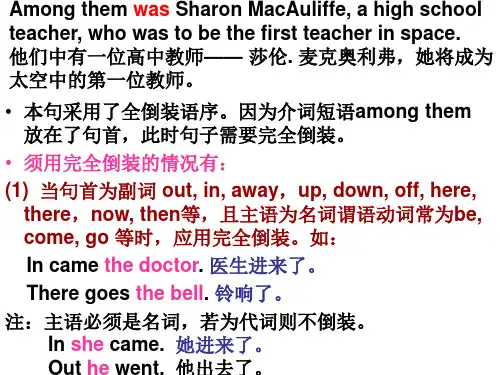

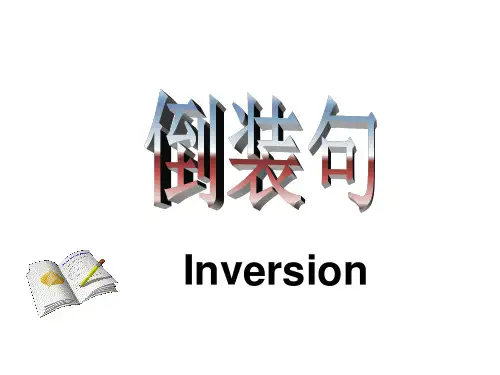
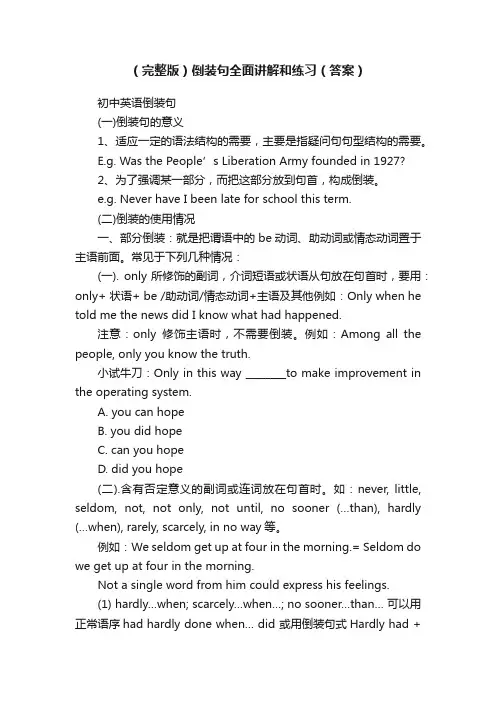
(完整版)倒装句全面讲解和练习(答案)初中英语倒装句(一)倒装句的意义1、适应一定的语法结构的需要,主要是指疑问句句型结构的需要。
E.g. Was the People’s Liberation Army founded in 1927?2、为了强调某一部分,而把这部分放到句首,构成倒装。
e.g. Never have I been late for school this term.(二)倒装的使用情况一、部分倒装:就是把谓语中的be动词、助动词或情态动词置于主语前面。
常见于下列几种情况:(一). only所修饰的副词,介词短语或状语从句放在句首时,要用:only+ 状语+ be /助动词/情态动词+主语及其他例如:Only when he told me the news did I know what had happened.注意:only修饰主语时,不需要倒装。
例如:Among all the people, only you know the truth.小试牛刀:Only in this way ________to make improvement in the operating system.A. you can hopeB. you did hopeC. can you hopeD. did you hope(二).含有否定意义的副词或连词放在句首时。
如:never, little, seldom, not, not only, not until, no sooner (…than), hardly (…when), rarely, scarcely, in no way等。
例如:We seldom get up at four in the morning.= Seldom do we get up at four in the morning.Not a single word from him could express his feelings.(1) hardly…when; scarcely…when…; no sooner…than… 可以用正常语序had hardly done when… did 或用倒装句式Hardly had +主语+ done when… did 句式。
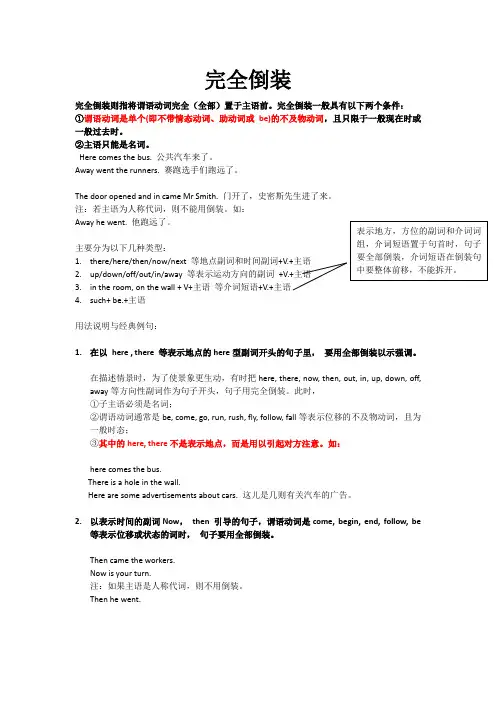
完全倒装完全倒装则指将谓语动词完全(全部)置于主语前。
完全倒装一般具有以下两个条件:①谓语动词是单个(即不带情态动词、助动词或be)的不及物动词,且只限于一般现在时或一般过去时。
②主语只能是名词。
Here comes the bus. 公共汽车来了。
Away went the runners. 赛跑选手们跑远了。
The door opened and in came Mr Smith. 门开了,史密斯先生进了来。
注:若主语为人称代词,则不能用倒装。
如:Away he went. 他跑远了。
主要分为以下几种类型:1.there/here/then/now/next 等地点副词和时间副词+V.+主语2.up/down/off/out/in/away 等表示运动方向的副词+V.+主语3.in the room, on the wall + V+主语等介词短语+V.+主语4.such+ be.+主语用法说明与经典例句:1.在以here , there 等表示地点的here型副词开头的句子里,要用全部倒装以示强调。
在描述情景时,为了使景象更生动,有时把here, there, now, then, out, in, up, down, off, away等方向性副词作为句子开头,句子用完全倒装。
此时,①子主语必须是名词;②谓语动词通常是be, come, go, run, rush, fly, follow, fall等表示位移的不及物动词,且为一般时态;③其中的here, there不是表示地点,而是用以引起对方注意。
如:here comes the bus.There is a hole in the wall.Here are some advertisements about cars. 这儿是几则有关汽车的广告。
2.以表示时间的副词Now,then 引导的句子,谓语动词是come, begin, end, follow, be等表示位移或状态的词时,句子要用全部倒装。
“作状语的介词短语放于句首引起的倒装句”的基本用法有时为了强调而将作状语的介词短语放在句首,而将主语放到句末从而形成倒装,这种倒装句中的谓语多为以下不及物动词:come, lie, stand, walk, 且为全部倒装的形式。
例如:Under the big tree was sitting an old farmer. 大树下坐着一个老农夫。
// Along the dusty road came a group of tourists. 一群游客沿着尘土飞扬的路走来。
// In the distance could be seen the purple mountains. 在远处,可见到紫红色的群山。
采用这样的倒装形式有时也是出于全句平衡的考虑:当主语较长时,为了使句子平衡,常以作状语的介词短语开头。
例如:On the ground lay some air conditioners, which are to be shipped to some other cities. 地上放着一些空调,它们会被船运到其他城市去。
介词短语置于句置时的倒装说明■在通常情况下,介词短语置于句置时其后的句子是不用倒装的。
如:At the end there may be an index. 结尾处可能有索引。
On the platform she kissed her mother. 她在月台上吻了她的母亲。
Before the meeting I looked through the reports. 开会前我把报告看了一遍。
From the balloon we could see the town far below. 从热气球上我们可以看到下方远处的小镇。
■但是,有时为了保持句子平衡或使上下文衔接紧密,有时可将用作地点状语的介词短语置于句首,此时句中主语和谓语完全倒装。
这类句子所涉及的动词通常是表示姿势的不及动词(如crouch, hang, lie, sit, stand等)和表示行动的不及物动词(如come, die, go, run, live, rise 等)。
英语部分倒装用法归纳1. 否定副词位于句首时的倒装在正式文体中,never, seldom, rarely, little, hardly, scarcely, no sooner, no longer, nowhere 等含有否定意义的副词若位于句首,则其后要用部分倒装:I shall never forgive him. / Never shall I forgive him. 我永远不会宽恕他。
He seldom goes out for dinner. / Seldom does he go out for dinner. 他很少出去吃饭。
She hardly has time to listen to music. / Hardly does she have time to listen to music. 她几乎没时间听音乐。
He little realizes how important this meeting is. / Little does he realize how important this meeting is. 他不甚明白这个会议的重要性。
We had no sooner reached the airport than the plane took off. / No sooner had we reached the airport than the plane took off. 我们刚到机场,飞机就起飞了。
【注意】(1) 对于not…until句型,当not until…位于句首时,其后的主句要用倒装语序:He didn’t leave the ro om until the rain stopped. / Not until the rain stopped did he leave the room. 雨停了之后他才离开这房间。
(2) 某些起副词作用的介词短语,由于含有否定词,若位于句首,其后要用部分倒装:On no accounts must this switch be touched. 这个开关是绝不能触摸的。
倒装句口诀副介开头要倒装,人称代词则如常。
ONLY修饰副介状,位于句首半倒装。
否定意义副连介,表示“也不”也倒装。
NOTONLY开头句,前一分句须倒装。
HAD,WERE,SHOUL虚拟句,省略IF半倒装。
SO/SUCH置于句首表强调,主句需用半倒装。
口诀解释1.副介开头要倒装,人称代词则如常。
在IN,OUT,UP,DOWN,AWAY,HERE,THERE,INFRON等OF司或介词短语开头的句子里,用完全倒装。
但当主语是人称代词时,句子的语序不变。
如:AWAYWENTTHEGIRL.HEREHECOMES.2.ONLY修饰副介状,位于句首半倒装。
当ONLY修饰的副词、介词短语或状语从句置于句首时,句子要部分倒装。
如:ONLYTHENDIDIREALIZETHATIWASWRONG.ONLYINTHISWAYCANYOUIMPROVEYOURLISTENING.3. 否定意义副连介,表示“也不”也倒装。
含有否定意义的副词、连词或介词短语位于句首时,句子要部分倒装。
常见的这类单词或短语有:NEVER,HARDLY,SELDOM,NOWHERE,RARELY,NOTUNTIL,BYNOMEANS,INNOWAY, INNOTIME 等。
如:NOTUNTILYOU VEDONEYOURHOMEWORKCANYOUPLAYNOW.NEITH位R,NOR于句首表示前面否定的内容也适用于另一人或物时,句子须用倒装,其结构为“ NEITHER/NOR+BE动词/情态动词+主语”女口:HEDOESN'TLIKEBEETHOVENANDNEITHERDOI.4. NOTONLY开头句,前一分句须倒装。
NOTONL Y---BUT(ALSO)连接两个分句时,若NOTONLY位于句首,前一个分句用部分倒装结构。
如:NOTONL YDIDIPA YOFFALLM YDEBTS,BUTISTILLSAVEDSOMEMONE Y.5. HAD,WERE,SHOUL虚拟句,省略IF半倒装。
There be句型1、明天我们学校有一场英语演讲比赛。
2、自由女神像the Statue of Liberty矗立在纽约港口。
3、有条河在这座城市里流过。
表地点的介词短语位于句首1、我校是一所省重点高中,位于海丰县城北。
校园很美,绿树成荫。
2、山顶上有一座古寺,已经有1000多年的历史了。
3、墙上有个通知,上面写着“请节约用水”.强调表语1、上周五高二年级进行了一场英语演讲比赛。
出席的人有高二级全体学生、高二全体英语老师及校领导。
半倒装so/such ~~~that ~~~句型1、时间是如此珍贵,我们不能浪费它。
2、他如此沉溺于网络游戏以致于他的成绩下降得很厉害。
3、我们有如此多的作业要做以至于我们没有时间放松。
4、这个问题如此的严重,以至于我们不得不找到有效的解决办法。
1、我们绝对不能忽略知识的价值,以及实际的经验。
2、不论什么原因游客都不允许用东西喂动物。
3、青年人决不应疏忽每天的体育锻炼。
4、环境对于我们来说就好像鱼儿离不开水-我们绝对没法脱离它而生存。
5、依我看,我们绝不能把财富和幸福等同起来.我还认为人们永远也不应该只依靠财富去实现幸福。
Only+状语1、只有我们每个人都意识到水的重要性, 我们才能生活得更好.2、只有用这种方式, 我们才能有足够的精力好好学习.3、只能通过联合努力我们才能快速发展。
not only~~~but also~~~1、广告不仅让我们了解最新的产品而且还很有娱乐性。
2、学习做饭不仅使孩子们更加独立,而且还可以让他们远离垃圾食品。
as/though引导让步状从1、虽然我们的国家富有,我们的生活品质绝对令人不满意。
2、尽管钱很重要,但它买不来幸福。
3、尽管Lily是个新老师,她很受学生欢迎。
4、尽管他已经非常努力了,可他最后还是没有通过考试。
There be句型1、明天我们学校有一场英语演讲比赛。
2、自由女神像the Statue of Liberty矗立在纽约港口。
倒装句(主倒,从不倒)(一)全倒装:1,句型there be(有) + 某物(主语) +在某处(介词短语);2,表语(形容词/过去分词/介词短语)+Be+主语3,用于“here(there, now, then, out, up, in, down, away etc) + vi +S(主语)以表示强调;Here comes the bus. Away hurried the man. 但代词作主语,主谓语序不变。
Away he hurried.4,表示地点的介词词组作状语在句首时+vi +S(主语);5,So/Nor/Neither/+助动词/系动词/情态动词+主语(也可+与前句不同的另外谓语动词)两个不同动词的句子用so it is / was with sb.= it is/was the same with sb.(So+主语+谓语:"的确如此")6,为了保持句子平衡,或强调使上下文紧密衔接时;They arrived at a farmhouse, in front of which sat a small boy。
(二)半倒装:1,as表示“尽管”引导让步状语从句:名词(无冠词)/形容词/副词/动词+as+主语+谓语Child as he is, he knows a lot. Much as I like it, I’ll not buy it. Try as he would, he might fail again.2,省略if条件句中:were/had/should +主语+部分谓语+其它:If I were you=Were I you, I would go.3, never, hardly, seldom, scarcely, barely, little, often, not, at no time, in no way, not only, not once,many a time,hardly had+S+done...when,n o sooner..than,not until,so+adj./adv…that,such+adj.+n.…that, every two hours,now and then, every other day, not everywhere, nowhere(else)等副词在句首时+助动词/系动词/情态动词+主谓;4,O nly+副词/介词短语/状语从句+助动词/ 系动词/情态动词+主谓。
倒装句的高考考点:全部倒装:1. 在以here、there、now、then、off、away等副词开头的句子里。
2. 表示地点的介词短语位于句首时。
部分倒装1、Only+状语位于句首时2.否定副词或短语位于句首时3、as引导的让步状语从句4、So\ Neither\ Nor 位于句首时5、特殊句式6、在省去if的虚拟条件从句中倒装句倒装是一种语法手段,用以表示一定句子结构的需要和强调某一句子成分的需要,分为完全倒装和部分倒装。
A.Here comes the car.(全部倒装)全部倒装:只将句子中的谓语动词全部置于主语之前。
此结构通常只用与一般现在时和一般过去时。
Away went the boy.B. Never have I seen this kind of car. (部分倒装)部分倒装:be/助动词/情态动词提前到主语的前面。
一.完全倒装There goes the bell. 铃响了Here comes the bus. 公共汽车来了Away went the boy. 那个男孩走开了。
Out rushed the children. 小孩子冲了出来。
1.以here, there, now, then等副词或out, in, up, down, away等表示运动方向的副词或地点状语置于句首以示强调,句子要全部倒装,谓语动词常用come,go, be, lie,run,rush等。
2. 表示地点的介词短语位于句首时A beautiful lake lies at the foot of the hillAt the foot of the hill lies a beautiful lake.注意:在上述句子中,如果主语为人称代词,则主、谓不需要倒装。
In he came and back he went again.Away he went .二.部分倒装把be/助动词/情态动词提前到主语的前面Is am are was were(be动词)do does did(助动词)can could would may will might(情态动词)等1.only所修饰的副词、介词短语或状语从句放在句首时, 要进行部分倒装.Only then did I realize the importance of learning English.Only after he came back was I able to see him.注:only修饰主语,仍用自然语序,如:Only socialism can save China.I seldom go to the cinema.倒装:Seldom do I go to the cinema.我很少去看电影.I have never seen such a performance.倒装:Never have I seen such a performance.我从来没有看过这样的表演.2.否定副词及介词短语的否定词位于句首时。
介词短语置于句置时的倒装
■在通常情况下,介词短语置于句置时其后的句子是不用倒装的。
如:
At the end there may be an index. 结尾处可能有索引。
On the platform she kissed her mother. 她在月台上吻了她的母亲。
Before the meeting I looked through the reports. 开会前我把报告看了一遍。
From the balloon we could see the town far below. 从热气球上我们可以看到下方远处的小镇。
■但是,有时为了保持句子平衡或使上下文衔接紧密,有时可将用作地点状语的介词短语置于句首,此时句中主语和谓语完全倒装。
这类句子所涉及的动词通常是表示姿势的不及动词(如crouch, hang, lie, sit, stand等)和表示行动的不及物动词(如come, die, go, run, li ve, rise等)。
如:
On the door hung a big sign. 门上挂着一个大招牌。
Over the wall came a shower of stones. 从墙上飞来一阵石块。
Round the comer came Mrs Porter. 波特夫人在拐角上出现了。
On the top of the hill stood an old castle. 山丘上有一座古堡。
Under the road run pipes for gas and water. 在马路下面铺着煤气管道和自来水管。
Before them lay miles of undulating moorland. 他们前面是一片高低起伏的荒原。
■少数情况下,及物动词的被动语态有时也可以倒装。
如:
In the distance could be seen the purple mountains. 远处可以见到紫色的山。
■另外,有时用于句首的介词短语也可能是句子表语,此时要注意其中的谓语应与其后的主语保持一致,而不是与位于句首的表语保持一致。
比较:
In the box was a cat. 箱子里是一只猫。
In the box were some cats. 箱子里是一些猫。
表语或状语置于句首时的完全倒装
有时为了强调或者为了使句子平衡或者为了使上下文连接得更加紧密,就将表语和地点状语(多为介词短语)置于句首,谓语动词也常置于主语前,构成完全倒装。
如:By the door stood an armed guard. 门口站着一名手持武器的士兵。
At the next table was a pretty girl waiting for someone. 隔壁桌上坐着一个等人的漂亮姑娘。
Among these people was his friend Jim. 他的朋友吉姆就在这些人当中。
By the window sat a young man with a magazine in his hand. 窗户边坐着一个年轻人,手里拿着一本杂志。
At the front of the book is a table of contents, giving details of what is in the book.书的前部有目录,详列了书中的内容。
地点状语后的倒装
地点状语后面如有表示位置的动词(如lie, live, sit, stand) 或转移的动词(如come, go, rise),用作主语的名词可以放在动词之后。
这种情形主要出现在描写文中。
如:At the top of the hill stood the tiny chapel. 那座小教堂矗立在山顶上。
In the fields of poppies lay the dying soldiers. 罂粟地里躺着奄奄一息的士兵们。
别的动词如属被动语态也可以倒装。
In the distance could be seen the purple mountains. 远处可以见到紫色的山。
主语如是代词则不能倒装:
At the top of the hill it stood out against the sky. 它背衬青天矗立在山顶上。